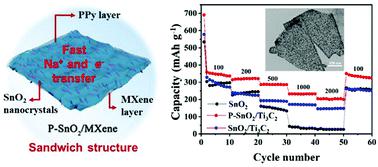当前位置:
X-MOL 学术
›
Mater. Chem. Front.
›
论文详情
Our official English website, www.x-mol.net, welcomes your
feedback! (Note: you will need to create a separate account there.)
Ultrasmall SnO2 nanocrystals sandwiched into polypyrrole and Ti3C2Tx MXene for highly effective sodium storage
Materials Chemistry Frontiers ( IF 6.0 ) Pub Date : 2020-10-30 , DOI: 10.1039/d0qm00598c Jianfeng Ding 1, 2, 3, 4 , Cheng Tang 5, 6, 7, 8, 9 , Guanjia Zhu 1, 2, 3, 4 , Fengyi He 1, 2, 3, 4 , Aijun Du 5, 6, 7, 8, 9 , Minghong Wu 2, 3, 4, 10 , Haijiao Zhang 1, 2, 3, 4
Materials Chemistry Frontiers ( IF 6.0 ) Pub Date : 2020-10-30 , DOI: 10.1039/d0qm00598c Jianfeng Ding 1, 2, 3, 4 , Cheng Tang 5, 6, 7, 8, 9 , Guanjia Zhu 1, 2, 3, 4 , Fengyi He 1, 2, 3, 4 , Aijun Du 5, 6, 7, 8, 9 , Minghong Wu 2, 3, 4, 10 , Haijiao Zhang 1, 2, 3, 4
Affiliation

|
The main challenge for developing transition metal oxides (TMOs) as anode materials for sodium-ion batteries (SIBs) is to rationally design and synthesize TMO-based hybrid structures and precisely control the transport of ions and electrons. Herein, we propose a facile in situ interfacial growth strategy to achieve a novel sandwich structured P-SnO2/Ti3C2 composite, where SnO2 nanocrystals modified with an ulthathin polypyrrole (PPy) layer of about 3 nm are strongly coupled with Ti3C2Tx Mxene nanosheets through Sn–O–Ti chemical bonds. Uniformly dispersed SnO2 nanocrystals confined in PPy and Ti3C2Tx nanosheets provide abundant acitve sites, while the conductive polymer PPy and Ti3C2Tx serve as robust protective layers alleviating the volume expansion and fast channels for Na ions and electron transport. Thanks to the advantages of structure and composition, the resulting P-SnO2/Ti3C2 anode demonstrates excellent sodium storage properties in terms of long cycle life (325.6 mA h g−1 at 100 mA g−1 after 100 cycles) and outstanding rate performance (204.4 mA h g−1 at 1000 mA g−1). The density functional theory calculations further prove that the P-SnO2/Ti3C2 heterostructure can balance the adsorption and release of Na atoms on the interface, thus boosting the performance of SIBs. This approach developed can also provide valuable guidance for the constuction of more functional TMO-based composites.
中文翻译:

夹在聚吡咯和Ti3C2Tx MXene中的超小SnO2纳米晶体可高效储存钠
开发用作钠离子电池(SIB)负极材料的过渡金属氧化物(TMO)的主要挑战是合理设计和合成基于TMO的混合结构,并精确控制离子和电子的传输。本文中,我们提出了一种简便的原位界面生长策略,以实现新型的三明治结构的P-SnO 2 / Ti 3 C 2复合材料,其中被约3 nm的ulthathin聚吡咯(PPy)层改性的SnO 2纳米晶体与Ti牢固结合。通过Sn–O–Ti化学键形成的3 C 2 T x甲苯纳米片。均匀分散在PPy和Ti中的SnO 2纳米晶体3 C 2 T x纳米片提供丰富的原子位置,而导电聚合物PPy和Ti 3 C 2 T x用作坚固的保护层,减轻了钠离子和电子传输的体积膨胀和快速通道。由于结构和组成的优势,所得的P-SnO 2 / Ti 3 C 2阳极在长循环寿命(100个循环后在100 mA g -1下为325.6 mA hg -1)下表现出优异的钠储存性能,并且具有出色的率性能(204.4毫安汞柱-1以1000mA克-1)。密度泛函理论计算进一步证明,P-SnO 2 / Ti 3 C 2异质结构可以平衡界面上Na原子的吸附和释放,从而提高SIB的性能。开发的这种方法还可以为功能性更强的TMO基复合材料的构建提供有价值的指导。
更新日期:2020-12-10
中文翻译:

夹在聚吡咯和Ti3C2Tx MXene中的超小SnO2纳米晶体可高效储存钠
开发用作钠离子电池(SIB)负极材料的过渡金属氧化物(TMO)的主要挑战是合理设计和合成基于TMO的混合结构,并精确控制离子和电子的传输。本文中,我们提出了一种简便的原位界面生长策略,以实现新型的三明治结构的P-SnO 2 / Ti 3 C 2复合材料,其中被约3 nm的ulthathin聚吡咯(PPy)层改性的SnO 2纳米晶体与Ti牢固结合。通过Sn–O–Ti化学键形成的3 C 2 T x甲苯纳米片。均匀分散在PPy和Ti中的SnO 2纳米晶体3 C 2 T x纳米片提供丰富的原子位置,而导电聚合物PPy和Ti 3 C 2 T x用作坚固的保护层,减轻了钠离子和电子传输的体积膨胀和快速通道。由于结构和组成的优势,所得的P-SnO 2 / Ti 3 C 2阳极在长循环寿命(100个循环后在100 mA g -1下为325.6 mA hg -1)下表现出优异的钠储存性能,并且具有出色的率性能(204.4毫安汞柱-1以1000mA克-1)。密度泛函理论计算进一步证明,P-SnO 2 / Ti 3 C 2异质结构可以平衡界面上Na原子的吸附和释放,从而提高SIB的性能。开发的这种方法还可以为功能性更强的TMO基复合材料的构建提供有价值的指导。











































 京公网安备 11010802027423号
京公网安备 11010802027423号